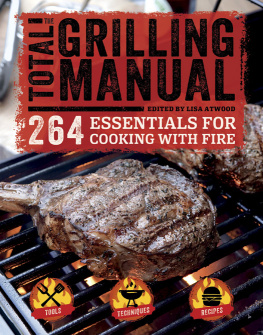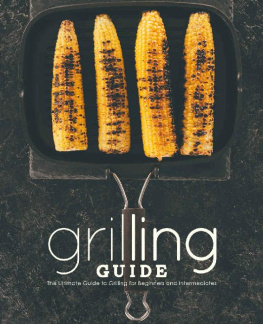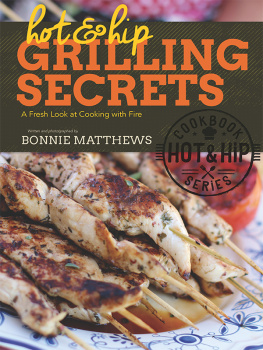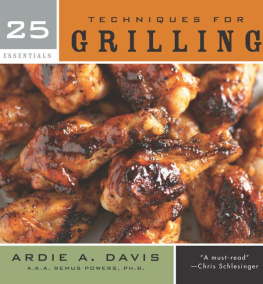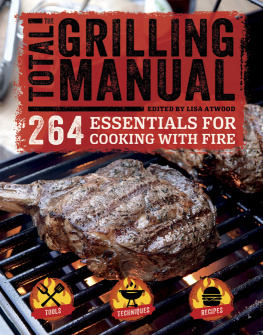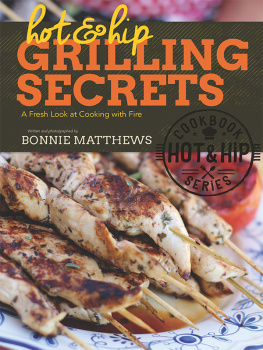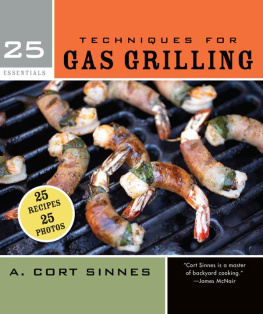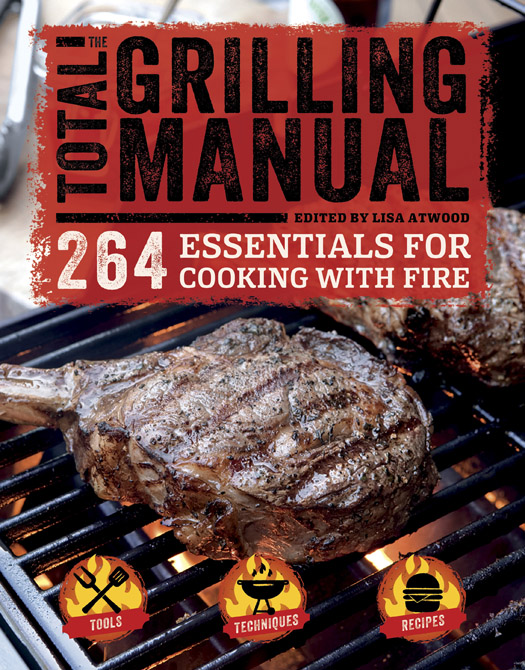


INTRODUCTION
Grilling is as much about culture as it is about technique. Whether what youre cooking is ruggedly primal or surprisingly sophisticated, the casual nature of cooking with fire makes it a universal pleasure. The simple techniques and communal atmosphere of a barbecue bring people together, whether for an impromptu dinner of burgers on a summer night or an all-day pig roast with all the trimmings.
Food roasted over an open flame was one of humanitys first culinary triumphs, and even today you can accomplish wonders with only an open flame and a succulent cut of your favorite meat. However, todays outdoor cooks have an incredible range of tools and appliances at their disposal, allowing us to grill whole fish, perfect pizzas, and delightful desserts as well as the usual suspects.
A growing interest in global grilling techniques adds to this lexicon, allowing backyard cooks to bring Korean bolgogi, Jamaican jerk chicken, Thai satay skewers, and more to the table alongside the more familiar pulled pork and barbecued ribs.
Armed with specialized gear and a world of recipes, modern grillmasters are equipped with everything they need to make that flame-cooked dinner as fancy or as simple as time, taste, and ingredients allow. Part of the fun is navigating the process.
The 264 tips, recipes, and techniques that follow cover everything about that process: all the basics, such as the pros and cons of cooking over gas or charcoal, indirect- and direct-heat cooking, choosing your fuel, and mastering your fire; and expert-level specifics, such as choosing a smoking wood, picking the right brine ingredients, and perfecting open-fire cookery. Learn the details of each cut of meat, master the art of flavor combinations, and take everything from the butcher to the table.
Recipes run the gamut from flash-grilled steak to tea-smoked duck breasts, from barbecued pizza to grill-roasted smores, with chapters devoted to beef, pork, lamb, poultry, and seafood, and liberally peppered with an arsenal of tools, techniques, rubs, marinades, sauces, sides, and drinks.
You have everything you need to know about grilling at your fingertips, so its time to get started. Fire it up and enjoy!
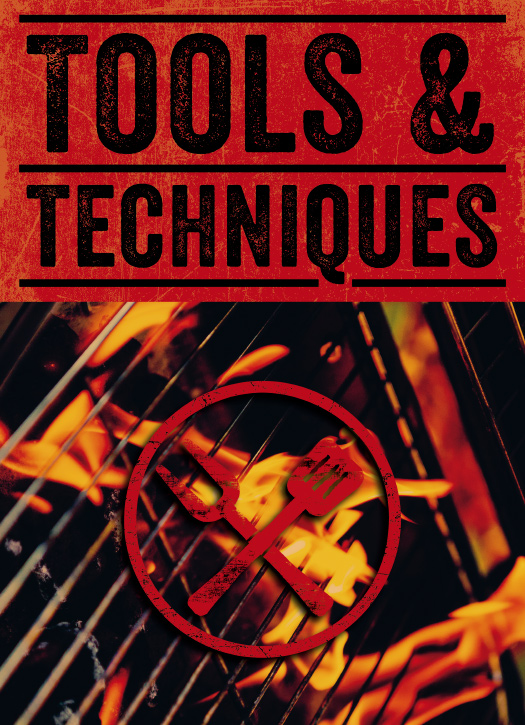

Cook with Fire
Starting a fire and cooking with it is both intrinsically primal and wonderfully practical. These days, cooking with fire has evolved to include a range of grilling and smoking options that begins with the selection of a charcoal or gas grill, and the accessories and tools that let you hone your technique. Here are the most popular options for the modern caveman.
CHARCOAL GRILLS When it comes to cooking with charcoal, you have a number of options to choose from. You can burn regular or hardwood charcoal briquettes or lump charcoal, and you can select from a wide range of grillsfrom small disposable picnic grills to a party-size ranch kettle model. Whatever your fancy, look for a well-built, high-grade steel grill that comes with a lid and at least two vents to control airflow and temperature. In the United States, perhaps the most quintessential grill model is the standard 22-inch (55-cm) kettle. It efficiently and quickly grills cuts of meat and seafood over a hot or medium-hot charcoal fire and can also be converted to accommodate longer-cooking foods that require low temperatures. Smaller charcoal grills, such as square or rectangular Japanese-style hibachis, are easily portable and perfect for grilling on the balcony or patio.

GAS GRILLS Gas grills run the gamut from a no-frills cart to a gadget-filled mini kitchen. They can be fueled by propane, making them at least somewhat portable, or connected to a homes natural-gas line. The gas flames heat stainless steel or enameled baffles, a rack of heat-absorbent ceramic briquettes, or a bed of lava rock underneath the grill rack. Dont know where to start? Heres the skinny: Two burners are a must, but if you plan to utilize an indirect cooking method (useful for many of the recipes in this book), three burners will make your life easier and give you better control. Dont get hung up on BTUs35,000 should be plenty. Instead, examine how the heat is diffused: angled metal plates covering the burners are particularly effective and reduce flare-ups. Look for cooking racks that are either plain stainless steel or stainless steel with a powder-paint finish. If your grill has an infrared burner, know that it will cook hotter than regular gas. Some models also have a searing station burner that produces an extra-hot heat for searing meat and vegetables prior to longer cooking on the grill.
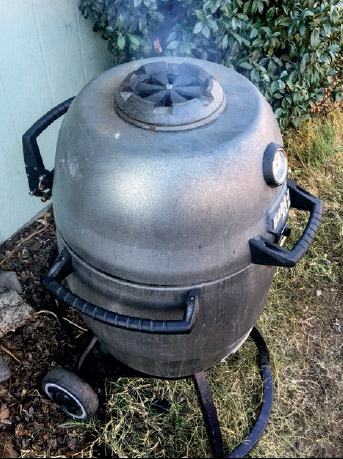
SMOKER GRILLS If what you want is low, slow cooking and lots of smoky flavor, look no further. Egg-shaped ceramic kamado -style smoker grills, such as the popular Big Green Egg, are prized for their unique heat retention and the distinctive flavor from the lump hardwood charcoal they burn for fuel. More traditional smokerswhich can be round, vertical, or bullet shapedcan be fired by gas or charcoal, usually with the addition of water-soaked wood chunks to provide their signature flavor. Most include a water pan in order to help keep the temperature low and the food nice and moist.
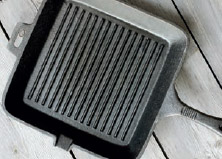
INDOOR GRILLS Are you outdoor-challenged? Never fear, theres a range of options for indoor grilling enthusiasts as well. Grill pans are excellent and widely available; they make cooking on your stovetop a snap. When it comes to materials, cast iron is the ideal choice for your grill pan; its easy to use, provides a good sear, and the pans are virtually indestructible (see ). If youre in a rush, look for preseasoned models, which are already prepped and ready for stovetop cooking.

Gear Up!
You can spend a lot of time, effort, and money collecting an array of high-tech accessories to craft a magazine-perfect grilling setup. Or you can round up the essentials listed here, and get grilling. Neither way is right nor wrong, but one gets burgers on your plate a lot faster.
KEEP CLEAN Youll need a long-handled wire brush for cleaning the grill: brass bristles are best for porcelain-enamel grates, steel for cast iron grates. Use the brush on the grate when its hot, both before and after cooking. Try a smaller, more angled brush with a stainless steel scraper for cleaning between the grate bars.

